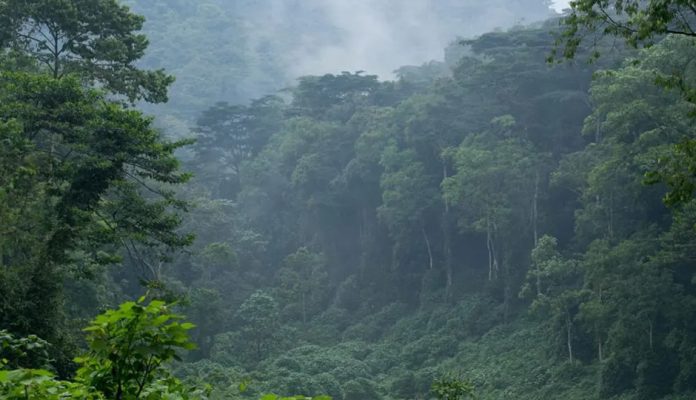The Democratic Republic of Congo boasts of some of the largest, very biodiverse and most endangered wildlife reserves on Earth. This country has everything you would ever desire in a destination. This large country takes prides in the natural sites with extraordinarily abundant biodiversity making it the richest/wealthiest country in the African Continent in terms of flora and fauna. The country’s biodiversity has been carefully Protected and conserved in some of the Reserves that are declared UNESCO World Heritage Sites due to their ecological and biological importance. Most importantly, the DR Congo has five wonderful World heritage Sites and they include;
Garamba National Park
Garamba National Park was established in 1938, making it one of the oldest National parks within the African continent and was declared a UNESCO World Heritage Site in 1980. It is characterized by large expanses of guinea savannah and open woodlands. Not only that, its Landscape is covered by several permanent water bodies that support the thriving of the abundant plants and animal species. Interestingly, the Park is a haven to some of Africa’s iconic wildlife species such as the elephants, White Rhinos, the Congo giraffe, Hippos, spotted hyenas, African lions and Common chimpanzees. However, only 30 white Rhinos are left within the National Park due to the high rate of poaching. Nonetheless, Garamba National Park is important due to its strategic location in the transition zone between the thick and humid forest ecosystems and the savanna. Conservation of this park is sometimes hindered by numerous rebel groups and poaching still remains one of the great threats to its conservation and sustainability.
Kahuzi-Biega National Park
This national park was established in 1970 mainly to protect the endangered Eastern lowland gorillas that are only found within the Democratic Republic of Congo. Kahuzi-Biega was declared a UNESCO World Heritage Site in 1980 and the Park shelters a mountain range dominated by the inactive Peaks of Mount Kahuzi and Biega. This Park covers an area of 36,000 square kilometers, borders the Congo Basin and the Albertine Rift and is characterized by thick lowland rain forest and montane forests. These forests offer haven to the native eastern lowland gorillas, the Red-faced chimpanzees and the small forest elephants among other interesting wildlife species. However, the Kahuzi Biega National Park is threatened by illegal mining and agricultural activities that degrade the Park’s habitats. Not only that, rebel groups also impede on the effective conservation of the park making the Park endangered.
Salonga Forest National Park
Salonga National Park was declared a UNESCO World Heritage Site in 1984 and stretches for 36,000 square kilometers in the Congo River Basin making it the second largest Forest National Park. It offers shelter to the thick rainforest and only reachable by either air or water transport. It is popular for offering shelter to exceptional species like the Dwarf chimpanzees, the Slender-snouted crocodiles (also known as the false crocodiles), Forest Elephants and the native Bonobos as well as exceptional birds such as the Congo peacock. Salongo rainforest is also known for the environmental significance for climate regulation and absorption of carbon. This Park is a haven to a population of the native pygmies and other local communities. However, the Park and its wildlife are threatened by rebel activities and poaching but several efforts are being taken to address these challenges.
Virunga National Park
The Virunga National Park is the oldest national park in Africa. It is one of the most famous destinations for gorilla safaris and frequented by tourists. It was declared a UNESCO World Heritage Site in 1979 and extends for 7800 square kilometers from the Southern side of Virunga Mountains to the Northern end of the Rwenzori Mountains. This park is a haven to a number of ecosystems that include the wetlands/swamps, steppe, the Afro-montane forests, the snowfields, savannah, lava plains and the Afro-alpine vegetation.
These ecosystems support abundant biodiversity species including the critically endangered mountain gorillas, forest buffaloes, the Common chimpanzees, the forest elephants, Hippos, over 78 species of Amphibians and more than 700 species of birds. Conservation of the Virunga National Park and its wildlife species was threatened by deforestation resulting from rebel activities, encroachment by the local communities and high rate of poaching.
Okapi Wildlife Reserve
This Wildlife Reserve was declared a UNESCO World Heritage Site in 1996. It comprises of almost one-fifth of the ituri Forest found in the North-eastern side of the country. Ituri Forest currently shelters a number endemic wildlife species including the Okapi. It was established in 1992 mainly to protect the nice looking forest giraffes known as the Okapi. Not only that, it is a home to the forest elephants, the forest buffaloes and the Bonobos. It is also a haven to the native Mbuti and Efe pygmies and the forest is culturally important to them. Much as the conservation of the Wildlife Reserve is well taken care of, threats such as poaching, rebel activities and encroachment still affects the habitats and wildlife species.
In conclusion, the DR Congo is a home to five UNSECO World Heritage Sites including Okapi Wildlife Reserve, Virunga National Park, Salonga Forest National Park, Kahuzi-Biega National Park and Garamba National Park with exceptional wildlife and bird species.






